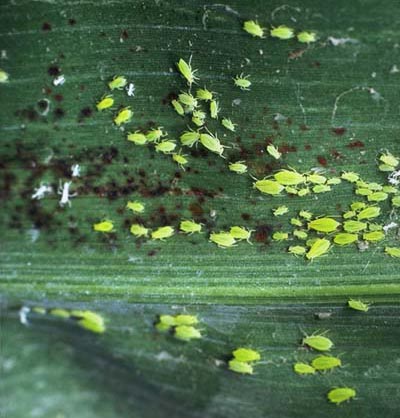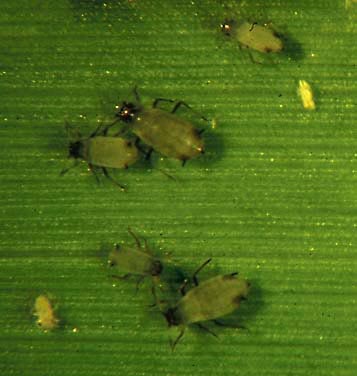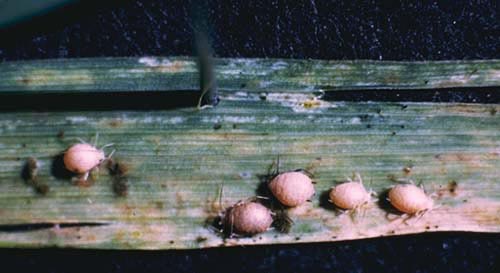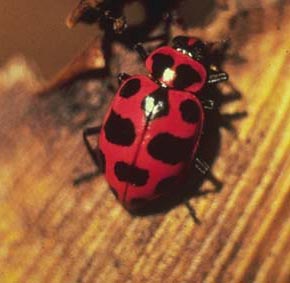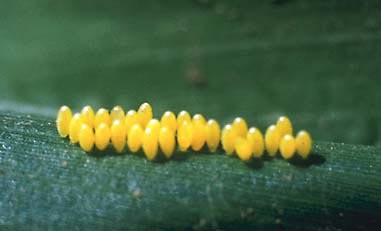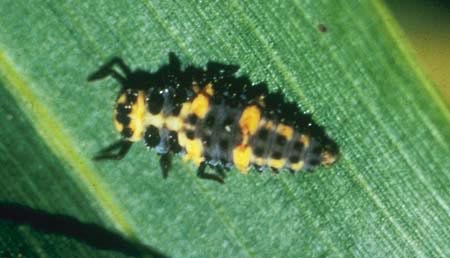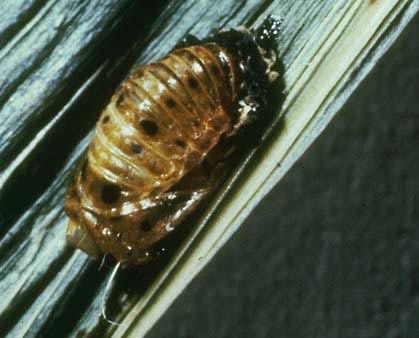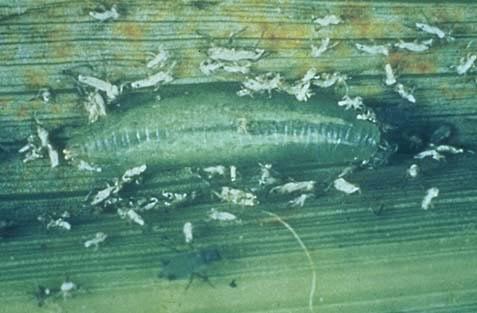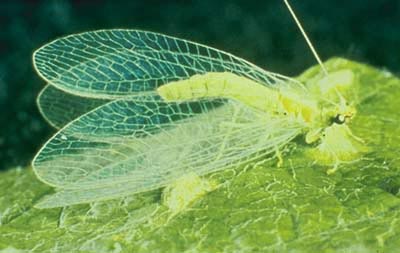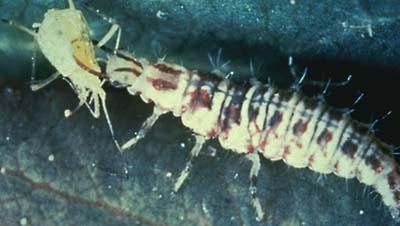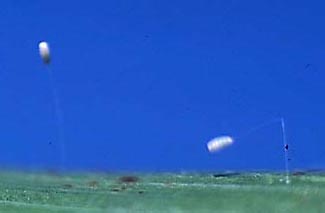G838
Management of Greenbugs in Sorghum
This NebGuide describes the identification, biology and management options for greenbugs in Nebraska sorghum.
Steve Danielson, Associate Professor of Entomology
ZB Mayo, Professor of Entomology
The greenbug is the most important insect pest of grain and forage sorghums in Nebraska. Although numbers fluctuate from year to year, greenbugs are a limiting factor to sorghum yield in most years. Their management is complicated by the fact that greenbugs have been able to evolve populations capable of overcoming plant resistance and organophosphate insecticides, so best management practices continue to change over time.
Another common aphid found in sorghum is the corn leaf aphid. Corn leaf aphids are often mistaken for greenbugs; however, they normally do not cause serious damage to sorghum, and controls for them rarely are justified in Nebraska.
Both winged and wingless greenbugs may be found in sorghum. All wingless greenbugs are female, and give birth to living young, all of which are female. Under optimal conditions (75°F), greenbugs can begin reproduction about seven days after birth, and one female can produce about 80 offspring over 25 days. Therefore, under ideal conditions, large numbers of greenbugs can be produced in a short time.
Greenbugs feed on a variety of grass crops, including wheat, oats, barley, rye and sorghum. Greenbugs suck sap with their needle-like mouthparts and inject a toxic saliva into plants. Greenbug feeding causes leaf discoloration and kills plant tissues.
Corn leaf aphids do not inject a toxic saliva as they feed, and have much lower potential to cause economic damage than greenbugs, so it is important to distinguish between these two aphids. The following illustrations and discussion should help distinguish between greenbugs and corn leaf aphids:
|
||||
|---|---|---|---|---|
Greenbugs (Figure 1). Greenbugs are light green or greenish-yellow aphids with a narrow, darker green stripe down the center of their backs. The legs of greenbugs are green, and their feet are black. The cornicles (small “pipes” near the rear end) are green with black tips. Greenbugs may develop in the whorls of young seedling plants. Some greenbugs may remain in the whorl until heading stage, but most will be found on the underside of the lower leaves from the seedling stage until the plant is mature, at which time the greenbug population declines, usually from the last week of July to mid-August.
Corn Leaf Aphids (Figure 1). Corn leaf aphids are darker blue-green and do not have a darker stripe down their backs. The heads, feet, legs and cornicles of corn leaf aphids are black. These insects develop in the whorl of the plant and usually disappear soon after heads emerge.
The greenbug first became a pest on grain sorghum in 1968 when a new population that was capable of surviving well on sorghum became abundant. This new population was designated “biotype C.” In 1980, grain sorghum hybrids resistant to biotype C suffered damage from greenbugs in some areas of the central plains states. This damage was caused by a new greenbug biotype, later designated as biotype E. These biotypes cannot be identified by their appearance, since they look the same. The different biotypes can only be identified by the feeding damage they cause to different varieties of sorghum or other species of plants. More recently, a new biotype, “I,” has been reported from Kansas which is able to reproduce on biotype E resistant sorghums. In the past several years, Biotype I has been the predominate greenbug biotype in Nebraska.
In most years, greenbugs do not overwinter in Nebraska, but migrate from states to the south (Texas, Oklahoma, Kansas) on weather fronts moving north. Winged greenbugs typically first appear in Nebraska sorghum in late May or early June. Although seedlings sometimes are killed by greenbugs, the population of greenbugs usually does not reach damaging levels until late June or July. Plants heavily infested in midsummer are severely damaged and suffer substantial yield reductions. The first evidence of damage to plants is yellow spots on leaves, followed by red patches or streaks that later turn brown. When large numbers of greenbugs are present, entire plants may turn brown and die. Colonies developing on undersides of leaves will cause reddish-brown spots visible from above. When colonies develop over most of the leaf surface, the entire leaf is killed. Usually lower leaves are most severely damaged.
Integrated pest management is a sustainable approach to managing pests by combining biological, cultural, physical and chemical tools in a way that minimizes economic, health and environmental risks. There are several factors to consider in developing an integrated pest management program for greenbugs on sorghum, including resistant varieties, planting date, crop residue, natural controls and insecticides.
Resistant varieties
The types of resistance bred into resistant hybrids are “tolerance” and “antibiosis.” Tolerance refers to the ability of a plant to survive the presence of pests and yield as well as a susceptible plant grown in the absence of pests. Antibiosis refers to factors in a plant that reduce the survival, growth or reproduction of a pest. Under natural conditions, resistant hybrid plants become infested with greenbugs, but they are not damaged to the same degree as genetically similar susceptible hybrid plants. Resistant hybrids may tolerate the aphids better, reduce the rate of increase of the greenbug population, suffer less damage, and generally yield more than susceptible hybrids. Yield increases have been obtained when insecticides are applied to either susceptible or resistant sorghums infested with greenbugs at economic levels.
Resistant hybrids possess a marked advantage for sorghum growers who do not treat for greenbugs. Planting resistant hybrids should reduce the probability of greenbugs destroying a newly emerged field or materially reducing yields. The ideal resistant hybrid should possess a high level of resistance and be agronomically adapted for the area in which it is grown.
Biotype I resistant sorghum hybrids have been highly effective in reducing greenbug damage. Biotype E resistant hybrids have not been consistently effective in reducing greenbug damage for several years. Many factors are involved in selecting the best sorghum hybrids for your fields. If well adapted Biotyope I resistant sorghum hybrids are available for your area, carefully consider whether they can fit into your overall needs. Greenbug populations are sporadic and it is not possible to predict when damaging populations will occur. Well adapted, high yielding, greenbug resistant hybrids provide an effective, low cost means to reduce damage from a sporadic pest like the greenbug. Greenbug growth and reproduction is slower, and it takes more greenbugs to damage greenbug resistant hybrids. This allows more time for beneficial insects such as lady beetles, lacewings and parasitic wasps to control greenbugs before economic damage occurs. Although greenbug numbers and damage are reduced on resistant varieties, economic levels may occur in some years. Be prepared to treat resistant hybrids with an insecticide if economic levels of greenbugs develop. Use of only one resistant hybrid in a large area over several years may increase the likelihood that new greenbug biotypes may develop. It is probably better in the long run to plant more than one hybrid on a farm, and vary the sources of resistance.
Planting date
The time of greenbug flights in the spring varies from year to year. The plant stage at the time of greenbug flights greatly influences whether economic damage will occur. Using a range of planting dates may limit damage by greenbugs to seedling plants by allowing some plantings to escape serious damage from spring greenbug flights.
Tillage
Research in Nebraska and other states has shown that flying greenbugs are more likely to land in fields with reduced amounts of vegetative cover. Fields with higher levels of residue cover, such as those in no-till or conservation tillage systems, often receive reduced numbers of flying greenbugs compared with fields farmed with conventional tillage which have bare ground.
Natural controls
There are several common natural factors that may reduce greenbug survival, including parasitic wasps, lady beetles, damsel bugs, syrphid fly larvae, green lacewing larvae, diseases and the weather.
|
|---|
A tiny wasp that deposits eggs inside greenbugs is the most important beneficial insect in reducing greenbug populations. Wasp larvae feed inside greenbugs, causing the aphids to die. Dying greenbugs first turn orange, then brown or tan at death. Dead greenbugs are called "mummies" (Figure 2). After the wasp adult emerges inside the aphid mummy, it cuts a circular hole to exit. These wasps have a relatively short life cycle and several generations can be produced during the growing season. When parasitism reaches 10 to 15 percent, natural control usually takes place in seven to 10 days, and insecticides may not be necessary.
Lady beetles and their larvae (alligator shaped, usually orange and black) (Figure 3) feed on aphids and often are effective in controlling low to moderate greenbug infestations. Several species are commonly found in Nebraska sorghum fields; adults may range in color from bright red to pink to grey in color, and often have black spots on their back. Lady beetle eggs are orange or yellow, football shaped and laid in small clusters on leaves. Lady beetles are often first attracted to sorghum by an early season infestation of corn leaf aphids. If there is an adequate aphid population, lady beetles will lay eggs in sorghum and the larvae will help control remaining aphids. If no aphids remain in the field the adult lady beetles will disperse to other crops.
|
||||||||
|---|---|---|---|---|---|---|---|---|
Although lady beetles are available from several mail order garden supply catalogs, purchased lady beetles are not suggested for greenbug control. These lady beetles are collected in their winter hibernation sites and require a period of flight before they begin feeding and reproduction. For this reason, they often do not remain in fields after release.
|
|---|
The immature stages of hover (or syrphid) flies (Figure 4) feed on a variety of aphids. These greenish larvae are typical fly maggots in appearance; legless, broadest at the tail end and tapering to a point at the head, with hook-like mouthparts. The adult flies feed on nectar and pollen (many species mimic bees in appearance) and may be seen hovering over blossoms.
Nabids or damsel bugs (Figure 5) are small (5/16 inch long), light brown, narrow insects with needle-like sucking mouthparts. Both immature and adult stages prey on greenbugs, small caterpillars and other small insects.
|
||||||
|---|---|---|---|---|---|---|
Green lacewing larvae (Figure 6) are grey, 1/2 inch long at maturity, with a pair of hook-like mouthparts extending from the head, which are used to pierce and hold onto their prey, while the body contents are consumed by sucking. These slender insects are sometimes described as being alligator-like in appearance. Green lacewing larvae feed on greenbugs, other aphids, small caterpillars and spider mites. Adult green lacewings feed on nectar and pollen, and have a slender green body, and a pair of clear delicate wings with a network of markings on them, making them look like lace. Each egg is laid on the end of a long upright silken stalk; eggs may be laid singly or in groups.
In wet years, dead greenbugs may be observed attached to sorghum leaves. Usually they are whitish or light tan in color, and they may have white growths protruding out of them. These have been killed by a fungus disease that is most effective under humid conditions.
Rainfall or irrigation also may cause mortality of greenbugs, particularly in early season infestations before the crop canopy has filled in. Greenbugs in the whorl may be washed off the plant, and as water droplets hit the ground and bounce up, they may knock greenbugs off of the plant, if the aphids are on the underside of the leaf.
Insecticides
If needed, insecticides should be applied as part of an integrated pest management plan, incorporating the use of plant resistance, tillage practices and natural controls to reduce greenbug growth to the extent possible.
Planting time treatments: Planting time insecticide applications or insecticide-treated sorghum seed (Gaucho or Cruiser) are effective means of controlling early season greenbug populations. However, Nebraska research has shown that seedling greenbug damage is uncommon in Nebraska.
From a control standpoint, registered granular and liquid planting time insecticides, and Gaucho- or Cruiser-treated seed provide effective control of greenbugs on seedling sorghum. In university tests over the past several years, Gaucho has provided 30-55 days of residual control of greenbugs, with granular insecticides providing slightly shorter residual activity. In recent tests, Cruiser has provided similar efficacy to Gaucho. None of these planting time treatments provided protection from late season infestations of greenbugs.
Foliar insecticides: Fields should be examined weekly for greenbugs, beginning with plant emergence. Examine a total of at least 40 plants from several locations within a field, noting abundance of greenbugs, their natural enemies, and signs of feeding injury (initially, yellow or reddish spots on lower leaves; later, leaves may die).
|
||||||||||
|---|---|---|---|---|---|---|---|---|---|---|
Compare results from scouting to the treatment guidelines in Table I. These treatment guidelines apply to both susceptible and resistant sorghum hybrids.
Small sorghum seedlings may be severely damaged by much lower populations (10 to 25 greenbugs) than will cause economic losses to larger plants later in the season. Applying a granulur soil systemic insecticide at planting time provides early season greenbug control. The use of granules at planting is primarily an effort to protect seedlings, rather than a procedure that may provide full season greenbug control. The residual control of any soil insecticide applied at planting is only about three to four weeks. Thereafter, when the greenbugs increase, the plants are no longer protected. Applications made at planting time are preventive treatments, and may or may not result in an economic return to the grower, depending on whether early season greenbug populations reach economic levels.
If greenbug numbers exceed the treatment guidelines (Table I), an insecticide treatment is suggested. Several options exist for insecticide use, including granular insecticides applied to the whorl or to the base of the plant and cultivated in, or liquid insecticides applied by ground or air equipment. Recommended or registered insecticides for greenbug control are listed in UNL Department of Entomology's Web.
Apply a minimum of 15 gallons of finished spray per acre with a ground sprayer. Equip the sprayer with drop nozzles so that spray may be directed up and under the bottom leaves. Apply two to three gallons per acre of finished spray by aircraft. Do not apply by aircraft if the temperature is above 95°F, or the wind is blowing more than eight miles per hour. Granules can be applied alongside the plants with cultivator-type granular applicators or broadcast by ground equipment.
Once established, greenbugs usually increase rapidly until early to mid-July, although populations fluctuate from year to year and from field to field, so the size and timing of infestations may vary. Ordinarily, reinfestation of treated fields is not serious. However, at times large flights of greenbugs occur in July. These winged aphids may reinfest fields in which the insecticide activity has disappeared. Therefore, it is important to continue to check greenbug levels, even in treated fields. A second treatment rarely is needed, except perhaps when a planting time treatment was used.
Forage sorghums: These are typically planted in early July, following harvest of small grains and run a greater risk of serious greenbug infestation in the seedling stage. For infestations on larger plants, treatment may be justified when 25 percent of the lower leaves have greenbug colonies and show signs of feeding damage.
Insecticide resistance: Greenbugs in southwest Kansas have been detected that are able to survive treatment with organophosphate insecticides (such as chlorpyrifos [Lorsban 4E]) used at rates that previously provided adequate control. Researchers in Kansas and other sorghum growing states have been monitoring this problem, and it is spreading. These insecticide resistant greenbugs have been detected in Nebraska but are not yet common. However, since greenbugs migrate into Nebraska from the south each year, it is possible that they will become more common in Nebraska in the future.
Use of the integrated pest management practices described above is the best way to reduce the likelihood that insecticide resistance will be a larger problem in the future. Other suggested practices include use of the lowest effective rate of insecticides, to limit selection for resistance in greenbugs. If a control failure is noted and other factors do not appear to explain it (for example, poor calibration, rainfall after treatment, high pH in spray tank), contact your local University of Nebraska–Lincoln Extension office.
Disclaimer
Reference to commercial products or businesses is made with the understanding that no discrimination is intended and no endorsement by University of Nebraska–Lincoln Extension is implied.
Index: Insects and Pests
Field Crops
1986, Revised 2006
